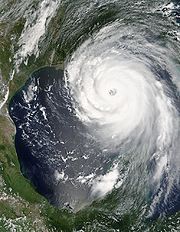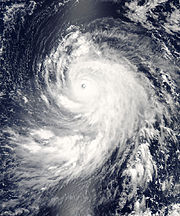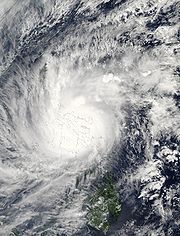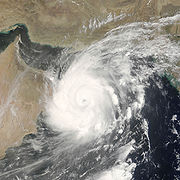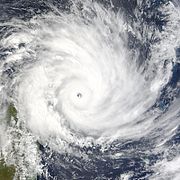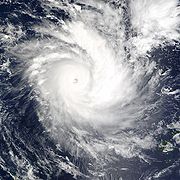- Lists of tropical cyclone names
-
Not to be confused with List of named tropical cyclones.
Part of a series on Tropical cyclones Formation and namingClimatology and tracking Tropical cyclones portal
Tropical cyclones portalDue to their long-term persistence, and the need for a unique identifier in issuing forecasts and warnings, tropical cyclones and subtropical cyclones are given names according to policy (see Tropical cyclone naming). The following are lists from which these tropical and subtropical cyclone names are derived.
Contents
North Atlantic
Within the North Atlantic ocean, tropical or subtropical cyclones are named by the National Hurricane Center (NHC/RSMC Miami) when they are judged to have intensified into a tropical storm with winds of at least 65 km/h, (40 mph). Six lists of names are used in alphabetical order, and maintained by the World Meteorological Organization with them rotating on a yearly basis. Significant tropical cyclones have their names retired from the lists with a replacement name selected at the next World Meteorological Organization (WMO), Regional Association IV Hurricane Committee meeting. If all of the names on a list are used, storms are named after the letters of the Greek alphabet (Alpha, Beta, Gamma, etc.). Greek names, unlike the names in the regular lists, cannot be retired. If a storm ever reached the magnitude that might otherwise have led to retirement, the storm would be listed with the retired names with a footnote indicating the Greek letter would still be available for future storms.[1][2][3]
2011 Arlene Bret Cindy Don Emily Franklin Gert Harvey Irene Jose Katia Lee Maria Nate Ophelia Philippe Rina Sean Tammy Vince Whitney 2012 Alberto Beryl Chris Debby Ernesto Florence Gordon Helene Isaac Joyce Kirk Leslie Michael Nadine Oscar Patty Rafael Sandy Tony Valerie William 2013 Andrea Barry Chantal Dorian Erin Fernand Gabrielle Humberto Ingrid Jerry Karen Lorenzo Melissa Nestor Olga Pablo Rebekah Sebastien Tanya Van Wendy 2014 Arthur Bertha Cristobal Dolly Edouard Fay Gonzalo Hanna Isaias Josephine Kyle Laura Marco Nana Omar Paulette Rene Sally Teddy Vicky Wilfred 2015 Ana Bill Claudette Danny Erika Fred Grace Henri Ida Joaquin Kate Larry Mindy Nicholas Odette Peter Rose Sam Teresa Victor Wanda 2016 Alex Bonnie Colin Danielle Earl Fiona Gaston Hermine Ian Julia Karl Lisa Matthew Nicole Otto Paula Richard Shary Tobias Virginie Walter Sources for tropical cyclone names.[1][2] Eastern Pacific Ocean
Within the Eastern Pacific Ocean there are two Regional Specialized Meteorological Centers (RSMC's) who assign names to tropical cyclones when they are judged to have intensified into a tropical storm with winds of at least 65 km/h, (40 mph). Tropical cyclones that intensify into tropical storms between the coast of Americas and 140°W are named by the National Hurricane Center (NHC/RSMC Miami), whilst tropical cyclones intensifying into tropical storms between 140°W and 180° are named by the Central Pacific Hurricane Center (CPHC/RSMC Honolulu). Significant tropical cyclones have their names retired from the lists and a replacement name selected at the next World Meteorological Organization Regional Association IV Hurricane Committee meeting. Should a tropical cyclone pass from the NHC's area of responsibility in to the CPHC's or vice versa it will retain its original name.[1][2]
North Pacific east of 140°W
When a tropical depression intensifies into a tropical storm to the north of the Equator between the coastline of the Americas and 140°W then it will be named by the NHC. Six lists of names are maintained by the World Meteorological Organization with them rotating on a yearly basis. Significant tropical cyclones have their names retired from the lists with a replacement name selected at the next World Meteorological Organization Regional Association IV Hurricane Committee meeting. If all of the names on a list are used, storms are then named after the letters of the Greek alphabet (Alpha, Beta, Gamma, etc.). Greek names, unlike the names in the regular lists, cannot be retired. If a storm ever reached the magnitude that might otherwise have led to retirement, the storm would be listed with the retired names with a footnote indicating the Greek letter would still be available for future storms.[1][2]
2011 Adrian Beatriz Calvin Dora Eugene Fernanda Greg Hilary Irwin Jova Kenneth Lidia Max Norma Otis Pilar Ramon Selma Todd Veronica Wiley Xina York Zelda 2012 Aletta Bud Carlotta Daniel Emilia Fabio Gilma Hector Ileana John Kristy Lane Martin Norman Olivia Paul Rosa Sergio Tara Vicente Willa Xavier Yolanda Zeke 2013 Alvin Barbara Cosme Dalila Erick Flossie Gil Henriette Ivo Juliette Kiko Lorena Manuel Narda Octave Priscilla Raymond Sonia Tico Velma Wallis Xina York Zelda 2014 Amanda Boris Cristina Douglas Elida Fausto Genevieve Hernan Iselle Julio Karina Lowell Marie Norbert Odile Polo Rachel Simon Trudy Vance Winnie Xavier Yolanda Zeke 2015 Andres Blanca Carlos Dolores Enrique Felicia Guillermo Hilda Ignacio Jimena Kevin Linda Marty Nora Olaf Patricia Rick Sandra Terry Vivian Waldo Xina York Zelda 2016 Agatha Blas Celia Darby Estelle Frank Georgette Howard Isis Javier Kay Lester Madeline Newton Orlene Paine Roslyn Seymour Tina Virgil Winifred Xavier Yolanda Zeke Sources for tropical cyclone names.[1][2] Central North Pacific (140°W to 180°)
When a tropical depression intensifies into a tropical storm to the north of the Equator between 140°W and 180° it is named by the CPHC. Four lists of names are maintained by the World Meteorological Organization, rotating without regard to year, with the first name for a new year being the next name in sequence that was not used the previous year. Significant tropical cyclones have their names retired from the lists, with a replacement name selected at the next World Meteorological Organization Regional Association IV Hurricane Committee meeting. The last name to be used from this list was Omeka, while the next one will be Pewa.[1][2]
List 1 Akoni Ema Hone Iona Keli Lala Moke Nolo Olana Pena Ulana Wale List 2 Aka Ekeka Hene Iolana Keoni Lino Mele Nona Oliwa Pama Upana Wene List 3 Alika Ele Huko Iopa Kika Lana Maka Neki Omeka Pewa Unala Wali List 4 Ana Ela Halola Iune Kilo Loke Malia Niala Oho Pali Ulika Walaka Sources for tropical cyclone names.[1][2] Western Pacific Ocean (180° to 100°E)
Within the Northwestern Pacific Ocean there are two separate agencies who assign names to tropical cyclones which often results in a cyclone having two names. The Japan Meteorological Agency names tropical cyclones should they be judged to have 10-minute sustained windspeeds of 65 km/h, (40 mph), to the north of the equator between the 180° and 100°E. The Philippine Atmospheric, Geophysical and Astronomical Services Administration assigns names to tropical cyclones which move into or form as a tropical depression in their area of responsibility located between 135°E and 115°E and between 5°N and 25°N even if the cyclone has had a name assigned to it by the Japan Meteorological Agency.
International names
Tropical Cyclones are named from the following lists by the Regional Specialized Meteorological Centre in Tokyo, Japan, once they reach tropical storm strength. Names are contributed by members of the ESCAP/WMO Typhoon Committee. Each of the 14 nations or territories submitted 10 names, which are used in alphabetical order, by the English name of the country.[4][5]
Contributing nation Cambodia China North Korea
(DPRK)Hong Kong Japan Laos Macau Malaysia Micronesia Philippines South Korea (ROK) Thailand USA Vietnam List 1 Damrey Haikui Kirogi Kai-Tak Tembin Bolaven Sanba Jelawat Ewiniar Maliksi Gaemi Prapiroon Maria Son-Tinh Bopha Wukong Sonamu Shanshan Yagi Leepi Bebinca Rumbia Soulik Cimaron Jebi Mangkhut Utor Trami List 2 Kong-rey Yutu Toraji Man-yi Usagi Pabuk Wutip Sepat Fitow Danas Nari Wipha Francisco Lekima Krosa Haiyan Podul Lingling Kajiki Faxai Peipah Tapah Mitag Hagibis Neoguri Rammasun Matmo Halong List 3 Nakri Fengshen Kalmaegi Fung-wong Kanmuri Phanfone Vongfong Nuri Sinlaku Hagupit Jangmi Mekkhala Higos Bavi Maysak Haishen Noul Dolphin Kujira Chan-hom Linfa Nangka Soudelor Molave Goni Atsani Etau Vamco List 4 Krovanh Dujuan Mujigae Choi-wan Koppu Champi In-Fa Melor Nepartak Lupit Mirinae Nida Omais Conson Chanthu Dianmu Mindulle Lionrock Kompasu Namtheun Malou Meranti [A 1] Malakas Megi Chaba Aere Songda List 5 Sarika Haima Meari Ma-on Tokage Nock-ten Muifa Merbok Nanmadol Talas Noru Kulap Roke Sonca Nesat Haitang Nalgae Banyan Washi Pakhar Sanvu Mawar Guchol Talim Doksuri Khanun Vicente Saola Sources for tropical cyclone names.[4][5] Philippines
The Philippine Atmospheric, Geophysical and Astronomical Services Administration uses its own naming scheme for tropical cyclones in their area of responsibility. PAGASA assigns names to tropical depressions that form within their area of responsibility, and any tropical cyclone that moves into their area of responsibility. Should the list of names for a given year prove to be insufficient, names are taken from an auxiliary list of names, with the first ten published every year.[6]
2011 Amang Bebeng Chedeng Dodong Egay Falcon Goring Hanna Ineng Juaning Kabayan Lando Mina Nonoy Onyok Pedring Quiel Ramon Sendong Tisoy Ursula Viring Weng Yoyoy Zigzag Abe Berto Charo Dado Estoy Felion Gening Herman Irma Jaime 2012 Ambo Butchoy Cosme Dindo Enteng [A 1] Gener Helen Igme Julian Karen Lawin Marce Nina Ofel Pablo Quinta Rolly Siony Tonyo Ulysses Vicky Warren Yoyong Zosimo Alakdan Baldo Clara Dencio Estong Felipe Gardo Heling Ismael Julio 2013 Auring Bising Crising Dante Emong Feria Gorio Huaning Isang Jolina Kiko Labuyo Maring Nando [A 1] [A 1] Quedan Ramil Santi Tino Urduja Vinta Wilma Yolanda Zoraida Alamid Bruno Conching Dolor Ernie Florante Gerardo Hernan Isko Jerome 2014 Agaton Basyang Caloy Domeng Ester Florita Glenda Henry Inday Juan Katring Luis Mario Neneng Ompong Paeng Queenie Ruby Seniang Tomas Usman Venus Waldo Yayang Zeny Agila Bagwis Chito Diego Elena Felino Gunding Harriet Indang Jessa Sources for tropical cyclone names.[6] North Indian Ocean (45°E – 100°E)
Within this basin, a tropical cyclone is assigned a name when it is judged to have reached Cyclonic Storm intensity with winds of 65 km/h (40 mph). The names were selected by members of the ESCAP/WMO panel on Tropical Cyclones between 2000 and May 2004, before the Regional Specialized Meteorological Center in New Delhi started to assign names in September 2004. There is no retirement of tropical cyclone names in this basin as the list of names is only scheduled to be used once before a new list of names is drawn up. Should a named tropical cyclone move into the basin, from the Western Pacific then it will retain its original name.
Contributing
NationsList 1 List 2 List 3 List 4 List 5 List 6 List 7 List 8 Bangladesh Onil Ogni Nisha Giri Helen Chapala Ockhi Fani India Agni Akash Bijli Jal Leher Megh Sagar Vayu Maldives Hibaru Gonu Aila Keila Madi Roanu Makunu Hikaa Myanmar Pyarr Yemyin Phyan Thane Na−nauk Kyant Daye Kyarr Oman Baaz Sidr Ward Murjan Hudhud Nada Luban Maha Pakistan Fanoos Nargis Laila Nilam Nilofar Vardah Titli Bulbul Sri Lanka Mala Rashmi Bandu Mahasen Priya Asiri Gigum Soba Thailand Mukda Khai−Muk Phet Phailin Komen Mora Phethai Amphan Sources for tropical cyclone names.[7] South-West Indian Ocean (90°E – 30°E)
Within the South-west Indian Ocean, tropical and subtropical depressions that are judged to have 10-minute sustained windspeeds of 65 km/h, (40 mph) or more for at least 6 hours by the Regional Specialized Meteorological Center on La Réunion Island, France are named. However it is the Sub-Regional Tropical Cyclone Advisory Centers in Mauritius and Madagascar who name the systems. The Sub-Regional Tropical Cyclone Advisory Center in Mauritius names the storm should it intensify into a moderate tropical storm between 55°E and 90°E; if the storm should intensify into a moderate tropical storm between 30°E and 55°E then the Sub-Regional Tropical Cyclone Advisory Center in Madagascar assigns the appropriate name to the storm. New name lists are used every year, whilst a name is normally only used once so thus no names are retired.[5][8]
2011-12 Alenga Benilde Chanda Dando Ethel Funso Giovanna Hilwa Irina Joni Kuena Lesego Michel Noyana Olivier Pokera Quincy Rebaone Salama Tristan Ursula Violet Wilson Xavier Yekela Zaina 2012-13 Anais Boldwin Claudia Dumile Emang Felleng Gino Haruna Imelda Jamala Kachay Luciano Mariam Njazi Onias Pelagie Quiliro Richard Solani Tamim Urilia Vuyane Wagner Xusa Yarona Zacarias Sources for tropical cyclone names.[8] Australian Region (90°E – 160°E)
Within the Australian Region there are five different official Tropical Cyclone Warning Centers who assign names to tropical cyclones. However as three of the warning centers are run by the Bureau of Meteorology of Australia, only 3 lists of names exist. A tropical low or a tropical depression will be judged to have intensified into a tropical cyclone if winds reach 65 km/h, (40 mph) and it is evident that gales are occurring more than halfway around the center. Significant tropical cyclones have their names retired from the lists and a replacement name selected at the next WMO Regional Association V Tropical Cyclone Committee meeting.[9]
When a tropical depression intensifies into a tropical cyclone between the Equator and 10°S and between 90°E and 141°E then it will be named by TCWC Jakarta. Should a tropical low intensify into a tropical cyclone between the Equator and 10°S and between 141°E and 160°E are assigned names by the Tropical Cyclone Warning Center in Port Moresby, Papua New Guinea. Tropical lows intensifying into tropical cyclones in all other areas between 90°E and 160°E as well as the Equator and 40°S are named by the Bureau of Meteorology of Australia.[8][9]
Indonesia
When a tropical depression intensifies into a tropical cyclone between the Equator and 10°S and between 90°E and 141°E it will be named by the Tropical Cyclone Warning Center in Jakarta, Indonesia. Names are currently assigned in sequence from list A, whilst list B details names that will replace names on list A that are retired.[9][10]
List A Anggrek Bakung Cempaka Dahlia Flamboyan Kenanga Lili Mawar Seroja Teratai List B Anggur Belimbing Duku Jambu Lengkeng Mangga Nangka Pisang Rambutan Sawo Sources for tropical cyclone names.[9][10] Australia
When a tropical low intensifies into a tropical cyclone between 10°S and 40°S and between 90°E and 160°E, then it will be named by one of the Tropical Cyclone Warning Centers in Perth, Darwin, or Brisbane. Starting with Anika, the names are assigned in alphabetical order with the lists used in rotating order without regard to year.[9][11]
Anika Billy Charlotte Dominic Ellie Freddy Gabrielle Herman Ilsa Jasper Kirrily Lincoln Megan Neville Olga Paul Robyn Sean Tasha Vince Zelia ------ Anthony Bianca Carlos Dianne Errol Fina Grant Heidi Iggy Jasmine Koji Lua Mitchell Narelle Oswald Peta Rusty Sandra Tim Victoria Zane ------ Alessia Bruce Christine Dylan Edna Fletcher Gillian Hadi Ita Jack Kate Lam Marcia Nathan Olwyn Quang Raquel Stan Tatjana Uriah Yvette ------ Alfred Blanche Caleb Debbie Ernie Frances Greg Hilda Ira Joyce Kelvin Linda Marcus Nora Owen Penny Riley Savannah Trevor Veronica Wallace ------ Ann Blake Claudia Damien Esther Ferdinand Gretel Harold Imogen Joshua Kimi Lucas Marian Noah Odette Paddy Ruby Seth Tiffany Verdun ------ ------ Sources for tropical cyclone names.[9][11] Papua New Guinea
When a tropical low intensifies into a tropical cyclone between the equator and 10°S and between 141°E and 160°E then it will be named by the Tropical Cyclone Warning Centers in Port Moresby, New Guinea. Names are assigned randomly by TCWC Port Moresby whilst list B details replacement names for list A which will be added in the bottom of list A to maintain the alphabetical order. As tropical cyclones rarely form in TCWC Port Moresby's area of responsibility when one does form the name is retired regardless of any impact reported.[9]
List A Alu Buri Dodo Emau Fere Hibu Ila Kama Lobu Maila List B Nou Obaha Paia Ranu Sabi Tau Ume Vali Wau Auram Source for tropical cyclone names.[9] Southern Pacific Ocean (160°E – 120°W)
Within the Southern Pacific a tropical depression is judged to have reach tropical cyclone intensity should it reach winds of 65 km/h (40 mph), and it is evident that gales are occurring at least halfway around the center. Tropical depressions that should intensify into a tropical cyclone between the Equator and 25°S and between 160°E and 120°W are named by the Regional Specialized Meteorological Center in Nadi, Fiji (RSMC Nadi). Should a Tropical Depression intensify to the south of 25°S between 160°E and 120°W, it will be named in conjunction with RSMC Nadi by the Tropical Cyclone Warning Center in Wellington, New Zealand (TCWC Wellington). Significant tropical cyclones have their names retired from the lists and a replacement name selected at the next World Meteorological Organization Regional Association V Tropical Cyclone Committee meeting, whilst tropical cyclones that move into the Australian region will retain its original name.[9]
List A Ana Bina Cody Dovi Eva Fili Gina Hagar Irene Judy Kerry Lola Mal Nat Olof Pita Rae Shelia Tam Urmil Vaianu Wati Xavier Yani Zita List B Arthur Becky Chip Denia Elisa Fotu Glen Hettie Innis Joni Ken Lin Moses Nisha Opeti Pearl Rene Sarah Troy [A 1] Vania Wilma ------ Yasi Zaka List C Atu Bune Cyril Daphne Evan Freda Garry Heley Ian June Kofi Lusi Mike Nute Odile Pam Reuben Solo Tuni Ula Victor Winston ------ Yalo Zena List D Amos Bart Colin Donna Ella Frank Gita Hali Iris Jo Kala Leo Mona Neil Oma Pami Rita Sarai Tino Ueta Vicky Wiki ------ Yolande Zazu List E
(Standby)Alvin Bela Cook Dean Eden Florin Garth Hart Isa June Kevin Louise Mia Niko Ola Pili Rex Suki Tasi Uraia Vanessa Wano ------ Yvonne Zidane Source for tropical cyclone names.[9][12] Other areas
Tropical cyclone formation is rare within the Mediterranean sea, South Atlantic and to the east of 120W in the Southern Pacific, as a result there are no official naming lists for these areas although in 2004, 2010 & 2011 when tropical cyclones formed within the South Atlantic they were named as Catarina, Anita and Arani.
See also
- List of previous tropical cyclone names
- European windstorm names
- List of Atlantic hurricane seasons
- List of Pacific hurricane seasons
- List of Pacific typhoon seasons
- List of North Indian Ocean cyclone seasons
- List of Southern Hemisphere tropical cyclone seasons
- List of Australian region cyclone seasons
- List of South-West Indian Ocean cyclone seasons
- List of South Pacific cyclone seasons
Notes
References
- ^ a b c d e f g Unattributed (2010-06-01). "RA IV Hurricane Operational Plan for North America, Central America and the Caribbean Hurricane Operational Plan" (PDF). Regional Association IV Hurricane Committee. World Meteorological Organization. http://www.wmo.int/pages/prog/www/tcp/documents/TCP30_2010_OpsPlan_En.pdf. Retrieved 2010-09-25.
- ^ a b c d e f g Unattributed. "Frequently asked questions: B: Tropical Cyclone Names". Atlantic Oceanographic and Meteorological Laboratory. National Oceanic and Atmospheric Administration. http://www.aoml.noaa.gov/hrd/tcfaq/B2.html.
- ^ Unattributed (2006-04-04). "RA IV Hurricane Committee Twenty-eighth Session report". Regional Association IV Hurricane Committee. World Meteorological Organization. Archived from the original on 2010-09-24. http://www.webcitation.org/5szgi2O7l. Retrieved 2010-09-24.
- ^ a b Unattributed (2009-01-21). "Tropical Cyclone names". Japan Meteorological Agency. http://www.jma.go.jp/jma/jma-eng/jma-center/rsmc-hp-pub-eg/tyname.html. Retrieved 2010-09-24.
- ^ a b c Unattributed (2010). "FAQ: B) Tropical cyclones names". Meteo France. http://www.meteo.fr/temps/domtom/La_Reunion/webcmrs9.0/anglais/faq/FAQ_Ang_B.html. Retrieved 2010-06-06.
- ^ a b Unattributed (2010-09-22). "Philippine Tropical cyclone names". Philippine Atmospheric, Geophysical and Astronomical Services Administration. http://www.webcitation.org/5sxZr5xi3. Retrieved 2010-09-23.
- ^ Unattributed (2010). "Tropical Cyclone Operational Plan for the Bay of Bengal and the Arabian Sea". World Meteorological Organization. http://www.imd.gov.in/section/nhac/dynamic/TCP-21.pdf. Retrieved 2011-07-02.
- ^ a b c Unattributed (2010). "Tropical Cyclone Operational Plan for the South-West Indian Ocean (2010)" (PDF). Regional Association I Tropical Cyclone Committee. World Meteorological Organization. http://www.wmo.int/pages/prog/www/tcp/documents/TCP-12_2010_English.pdf. Retrieved 2011-07-05.
- ^ a b c d e f g h i j Unattributed (2011-05-23). "Tropical Cyclone Operational Plan for the South-East Indian Ocean and the Southern Pacific Ocean" (PDF). RA V Tropical Cyclone Committee. World Meteorological Organization. http://www.wmo.int/pages/prog/www/tcp/documents/TCP-24_RAVOpPlan_2010.pdf. Retrieved 2011-05-23.
- ^ a b Unattributed. "Cyclone Names". Indonesian Meteorological and Geophysical Agency. http://meteo.bmkg.go.id/siklon/name. Retrieved 2008-12-14.
- ^ a b Unattributed. "Australian Bureau of Meteorology Tropical Cyclone Names". Bureau of Meteorology. http://www.webcitation.org/5qHzpcq1N. Retrieved 2010-06-06.
- ^ "Plan d'operations convernant les cyclones tropicaux dans le pacifique sud et le sudest de l'oc'ean Indien" (in French). World Meteorological Organization. 2011. pp. 21. http://www.wmo.int/pages/prog/www/tcp/documents/TD-292_TCP-24_2010_fr.pdf. Retrieved 2011-06-11.
External links
- United States National Hurricane Center – RSMC Miami
- United States Central Pacific Hurricane Center – RSMC Honolulu
- Japan Meteorological Agency – RSMC Tokyo
- India Meteorological Department – RSMC New Delhi
- Météo-France – RSMC La Reunion
- Indonesia Badan Meteorologi & Geofisika – TCWC Jakarta
- Australia Bureau of Meteorology – TCWC Perth, Darwin, Brisbane
- Fiji Meteorological Service – RSMC Nadi
- Meteorological Service of New Zealand – TCWC Wellington
Categories:- Lists of tropical cyclones
- Lists of names
Wikimedia Foundation. 2010.

